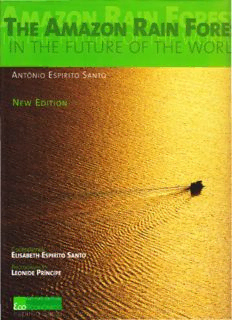
The Amazon Rain Forest in the Future of the World PDF
Preview The Amazon Rain Forest in the Future of the World
I THE FUTU E F THE W LEI DE tsBN 85-89357-01-5 INCENTIVO A cuIrURA llilllillilllillililll lllll ll MINISTE,nTo DA CUTIURA Apoio lnstitucional LEI DE Prefeitura do Municipio INCENTIVO de Sio Paulo A CUTTURA MINISTE,RIO DA (]I.J TURA PRESENTATION "In fact, citizenship goes far beyond speeches. Citizenship includes a respectful relation with the environment without the false pretexts of preservation that cast aside human beings or prevent their responsible access to the wealth it generates. Men of vision have long perceived this. Antonio Espfrito Santo was one of these visionaries. In this sense, The Amazon Rain Forest in the Future of the World is emblematic: the experience of the author, who lived in the region from 1951 to 1960, is openly shared without prejudice. BM&F, SCHAHIN GROUP and COMOLATII GROUP are proud to support this fourth edition of his work. As put by the author himself, "we are often astonished at the limited knowledge the foreigners have of our country, when we ourselves know so little about it. " The Amazon Rain Forest in the Future of the World is an excellent gateway to this special knowledge providing great insights into what biodiversity tru ly is, and how one of the most beautiful regions in the world can be explored with respect. One can also take great delight in Leonide Principe's superb images. We hope that this posthumous edition serves as a starting point for a great conscientious and democratic, prejudice-free discussion, and that through this book we can practice our citizenship even more. The Editor THE AMAZON RAIN FOREST FROM 1956 TO 2002 The author had a happy inspiration: he entered the core of the essential character of Brazil, trying to discover Amazonia for Brazilians. This discovery is a virgin sector. There is a lot yet to be discovered . The author penetrated deep into the Amazon Rain Forest. He didn't go in search of landscapes; he traveled all over this splendorous laboratory of Nature where God seems insatiable of phantasmagoric forms and is still testing the strength of his creative genius. In this way, the author tried to show Amazonia to Brazilians. And he left a legacy to be rescued. The first edition of this book was published in the early 50s. The author moved to Manaus in 1951, when the city lived a life isolated from the world and was immersed in the Amazon Rain Forest. Transportation was by water (Amazonia has the largest hydrographic basin in the world) and the air connections were made by the former Pan Air of Brazil "Catalinas PBY-5A", interconnecting the most remote localities in the region (such as these towns in the Amazon Rain Forest: Tefe, Tabatinga, Eirunepe, Moura, Pari-Cachoeira - a religious mission - among others), and by regular air lines flying to other places of the country. Public illumination came from power plants propelled by diesel oil. Manaus was one of the first Brazilian towns to have public illumination, which was an investment carried out by the industrialists of that time, result of good business with industrialization of rubber. When the author went there, the cycle of wealth brought about by rubber was almost over. Amazonia had not awoken yet to its greatness and to the international envy. The careful reading of the fourth edition of this book will take the reader to the past and will bring him back to the present bearing towards the future. He will become aware that almost nothing has changed, except the dispute about Amazonia. We still have to discover the "green paradise", where everything is transformed, where the resources remain natural, where survival is a difficult experience but a very gratifying one, where we are going to find solutions for countless problems that afflict mankind today. Possessing the largest natural heritage, in modern terms called biodiversity, Amazonia has great chances of turning Brazil into a country of first magnitude in worldwide economy. A country able to develop in the next ten years all that was not developed in the last fifty years. Only political intention and the success of modern science will be sufficient for this.
Description: